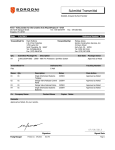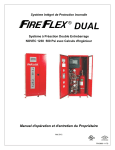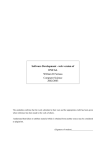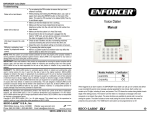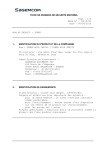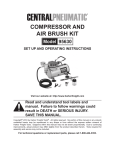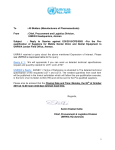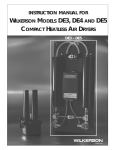Download Viking TBB-1 Owner`s manual
Transcript
Page 1 of 8 TOTALPAC2 Integrated Fire Protection System Air Supply Air Supply Section Preaction, dry valve and other sprinkler systems using air pressure for supervisory or releasing purposes are provided with either internal or external supervised air supplies. Four (4) styles of air supplies are available for the TOTALPAC2 units depending on needs or configurations. These air supplies are all factory assembled, mounted in the cabinet and pressure tested. They are all located in the top part of the cabinet, hung on mounting rails above the valve trim. Here is the description of those options: Air Option "A": (Refer to Figure 1) Used only for the sprinkler piping network of electrically operated preaction systems and with dry pipe systems. Air option "A" includes the air compressor mounted inside the TOTALPAC2 cabinet with its supervisory trim and options. Compressors are of the oiless piston type without reservoir and are factory piped to the sprinkler piping system riser, all within the TOTALPAC2 cabinet. They are available in four (4) sizes; 1/6HP 1/2HP 1/3HP 1HP. All the above air compressors have open, single phase motors with internal thermal protection and can be ordered in two supply voltages settings: 120Vac-60Hz or 220Vac-50Hz. The 120Vac-60Hz is the normal voltage used in Canada and the United-States while the 220Vac-50Hz is primarily used in Europe, Middle-East and other countries with 220 volts, 50 cycles current. Air Option "B": (Refer to Figure 2) Used only for the sprinkler piping network of preaction or dry pipe systems, when an external air supply is provided by others (either compressor, plant air or dry nitrogen cylinders) and piped to the air inlet port of the unit. Air option "B" provides an Air Pressure Maintenance Device (APMD) trim, factory mounted in the TOTALPAC2 cabinet. Note: For the releasing system piping of pneumatically actuated systems, use air supply type "C" or "D" below (with an external air compressor). Air Option "C": (Refer to Figure 3) Used only for the pneumatic release piping network of pneumatically operated preaction or deluge systems. An external air supply has to be provided by others (either compressor, plant air or dry nitrogen cylinders) and piped to the air inlet port of the unit. Air option "C" provides an Air Pressure Maintenance Device (APMD) trim, factory mounted in the TOTALPAC2 cabinet. Air Option "D": (Refer to Figure 4) Mainly used with preaction systems protecting refrigerated spaces and freezers, where a special dry external air supply unit is piped directly to the system riser inside the freezer itself, as shown in NFPA-13. Provides only an air supervisory and shut-off trim. Ambient temperature at the special external air supply unit o o location should not exceed 104 F (40 C). Refer to NFPA and Factory Mutual Codes & Standards for details on refrigerated spaces applications. Air option "D" can also be used when the contractor prefers to provide his own air supply & regulation trim, mounted outside the TOTALPAC2 cabinet. Note: When Air Options "B", "C" or "D" are selected, the air supply should be provided and installed by the sprinkler contractor OUTSIDE of the TOTALPAC2 Cabinet It is NOT provided with the unit. 1. Air supply design and selection: The air supply compressor should be sized to automatically establish the total required air pressure in 30 minutes. External air supply should be provided with an Air Maintenance Device (Air Option "B") to regulate and restrict the flow of supervisory air into the sprinkler system piping. Note: External air supply MUST always be restricted to insure that the automatic air supply cannot replace air as fast as it escapes when a sprinkler operates. WARNING! Pressures other than the factory pressure settings may affect the operation of the system. Air Compressor selection Table (Gast): Format (HP) Free Air @ 40 psi (CFM) Maximum Gallons in System to Pump to 40 psi in 30 Minutes 1/6 1.0 90 1/3 2.0 180 1/2 3.1 300 1 5.9 600 Note: Selection of the proper air compressor size is the responsibility of the installing contractor. 2. Connecting the Air Compressor to AC power (Air option "A" only): The motor must be protected against short circuit, overload and excessive temperature rise. Fuses, motor protective switches and thermal protective switches provide the necessary protection in these circumstances. Fuses only serve as a short circuit protection of the motor (wiring fault), not as protection against overload. Those are provided and wired by the electrical contractor. An isolation switch (for location detail, refer to Figure 2 in CONTROLS Section) is also provided in the TOTALPAC2 Cabinet and is factory wired, allowing powering off the air compressor while some maintenance work on the unit is done, without disturbing the rest of the system. Note: The air compressor is separately pre-wired to its own set of field wiring terminals identified TBB in the TOTALPAC2 controls compartment or junction box, depending on the enclosure configuration selected. These terminals must be wired to a separate and properly sized fuse or circuit breaker, different from the control panel FM-072G-0-06 G Page 2 of 8 TOTALPAC2® Integrated Fire Protection System Air Supply (when supplied). Observe all applicable codes for wiring of the unit. Connect non-energized AC power to the air compressor. Refer to figure below and FIELD WIRING DIAGRAM. .1 Connect the wire providing in-coming voltage to the terminal TBB #6. .2 Connect the neutral wire to the terminal marked TBB #5. .3 Connect the ground wire to the terminal marked TBB #4. Note: TBB #1, 2 & 3 when system is provided without control panel. INPUT POWER SOURCE 120Vac, 60Hz 220Vac, 50 Hz L1 NEUTRAL 1 2 3 4 5 6 GROUND GROUND NEUTRAL L2 TOTALPAC2 CONTROL PANEL (L1) 1.2A @ 120V - 0.65A @ 220V Turn clockwise to increase both cut-out and cut-in pressure adjustment. Factory set. DO NOT CHANGE ! AIR COMPRESSOR (L2) 1 HP Maximum FM-072Q-0-109 A TBB factory set. This switch should not need any adjustment but if necessary, follow the instructions below: .a Remove the metal cover of the compressor air pressure switch (E2). .b To raise the cut-out pressure of the air compressor, turn the cut-out adjustment screw (middle) half a turn CLOCKWISE. .c Open the system main drain valve (D3) and let the pressure drop until the air compressor (E1) restarts. Check pressure reading on the system pressure gauge (E3) when the air compressor stops again. Repeat until the desired pressure is reached. Once all done, replace the metal cover on the switch (E2). Wiring size: Minimum 14 AWG with 600V Insulation. TWO CIRCUITS ARE REQUIRED Compressor Size (HP) 1/6 1/3 ½ 1 Amp. Rating at 120Vac – 60Hz 3,9 5,8 12,0 10,4 Amp. Rating at 220Vac – 50Hz 2,0 2,9 6,0 5,2 3. Operation Air Option "A": .1 To Apply Air Supply: Establish 120Vac power for the air compressor by activating the correspondent circuit breaker at the electrical distribution panel. Start compressor by activating the compressor isolating switch (E15) located in the control section of the unit (refer to CONTROLS, Fig. 1 or 2 for exact location). If the air compressor motor fails to start or slows down under load, shut the compressor off. Check that the supply voltage agrees with the motor nameplate. A Float Check Valve (E9) is provided with Air Option "A". The Float Check Valve allows sensing of air pressure in the system during supervisory times of the system. .2 To close air supply: Turn off the compressor isolating switch (E15). .3 To adjust system air pressure (Furnass switch): WARNING: The cut-out/cut-in differential switch adjustment screw (small screw to the right) is factory set. DO NOT CHANGE ITS SETTING. Any unauthorised modification of this setscrew adjustment will void the system warranty and may also prevent the system from operating normally ! The air compressor cut-off pressure switch (E2) (shown below with its metal cover removed) has its air compressor cut-out adjustment switch (middle screw) FM-072G-0-06 G Front view of the Furnass Switch (Part # 69HA3) Note: Do not turn the cut-out adjustment screw (middle) all the way down in one shot. Proceed by steps. Use the same method turning the cut-out adjustment screw COUNTER-CLOCKWISE to lower the air compressor cutout pressure. Air options "B" or "C": .4 To Apply Air Supply: Turn on upstream air supply. Open APMD (Air Pressure Maintenance Device) input valve (E6) by placing handle in line with valve body then open APMD output valve (E7) by placing handle in line with the valve body. In order to accelerate filling of sprinkler piping by air pressure, bypass valve (E8) can be opened by placing handle in line with valve body while piping is initially filled by the air compressor,. This valve (E8) must then be closed (handle crossways to valve body) and kept in this position once the system is filled with air. .5 To Close Air Supply: Close APMD output valve (E7) by placing handle crossways to valve body then close APMD input valve (E6) by also placing handle crossways to the valve body. Be sure bypass valve (E8) is closed (handle crossways to valve body). .6 To Adjust System Air pressure: Be sure APMD input valve (E6) and APMD output valve (E7) are both open (handle in line with the valve body), and bypass valve (E8) is closed (handle crossways to valve body) prior to performing this operation. Loosen lock nut and turn pressure adjustment nut clockwise to Page 3 of 8 TOTALPAC2 Integrated Fire Protection System Air Supply increase air pressure or counter-clockwise to decrease pressure. Tighten lock nut. Note: Depending on site conditions, the internal filter of the APMD may need maintenance on a regular basis. Refer to Viking Data Sheet # 127a for more details. Air option "D": .7 To Apply Air Supply: Turn on upstream air supply. Open Bypass valve (E8) by placing handle in line with valve body. .8 To Close Air Supply: Close bypass valve (E8) (handle crossways to valve body). 4. Maintenance and inspection: Air Option "A": .1 To close the Air Supply: This procedure requires turning OFF the air compressor's AC power by switching off the compressor isolating switch (E15) located in the control section of the unit before servicing. Note that the air compressor motor is equipped with thermal protectors that reset automatically. These thermal protectors will stop the motor in case it overheats and can automatically start the motor when they reset. .2 To remove and clean the check valve assembly (E11): This procedure requires turning OFF the compressor's AC power. Follow instructions "To close Air Supply" above. .a Carefully loosen the ¼" copper adapter, remove copper tubing, and proceed to disassemble the check valve assembly (E11). .b Once disassembled, carefully clean the check valve seat, or replace the check valve (part # 40CHSW0002) altogether if worn out components are found. .c Remove all brass connections, by unscrewing gently all tubing adapters from the fittings, removing the previously installed Teflon tape and apply new Teflon tape on all threads. Re-install all components and check for leaks after reconnecting power to the air compressor. .3 To clean or replace the compressor's air inlet filter: This procedure requires turning OFF the compressor's AC power. Follow instructions "To close Air Supply" above. .a The motor compressor unit should be kept dirt-free. A dirty filter restricts air flow, and causes the pump to run hotter and results in longer operating cycles. .b To inspect the inlet filter, turn the black plastic cover counter-clockwise to remove it from its case (refer to Figure 1). Remove old felt. Clean or replace with new one (part # B 344 A). DO NOT CLEAN WITH PETROLEUM-BASED PRODUCTS. .c Re-install filter and cap. DO NOT OPERATE COMPRESSOR WITHOUT A FILTER. Note: Refer to the GAST Operation & Maintenance Technical Manual provided with the TOTALPAC2 unit for more details. Intake and exhaust filters are standard on most compressors and will provide adequate filtration for most applications. Check filters periodically and replace when necessary. Initial inspection is suggested at 500 hours, then the user should determine the frequency. Most problems can be prevented by keeping filters and mufflers clean. Dirty filters and mufflers decrease compressor performance and can decrease compressor service life. Should the compressor need rebuilding, field rebuilt kits are available from Gast or its Authorized Service Facilities. Refer to the compressor's Owner's Manual provided with the TOTALPAC2 unit. Maintain a clean air filter cartridge to insure best flow and performance. The location and the quality of the air being ingested indicates the frequency for inspection and replacement. A dirty filter restricts air flow, causes the pump to run hotter and results in longer operating cycles. .4 To drain the Air Supply Accumulator: The amount of moisture pumped into the system and how quickly it accumulates is proportional to the amount of humidity in the air and how long the compressor is in operation. This unit has been designed to operate o between 32 and 100 F. At least once a year, open air option Drain Valve (E12) until all condensate water is drained from the air receiver. Close air option Drain Valve. Warning ! The relief valve and outlet pipe of the air compressor may become very hot during normal operation. Do not touch the valve, compressor heads or outlet piping until the compressor has been turned off and allowed to cool. A safety relief valve is provided on standard compressors and is preset at the factory. Do not exceed or adjust safety relief pressures other than those preset at the factory. Warning ! Do not unscrew relief valve head entirely off while the compressor is operating. Ejection of valve parts could cause severe injury. Air Options "B" or "C": The Viking Model D-2 Air Pressure Maintenance Device (APMD) (E5) is a pressure regulator that automatically reduces the supply air pressure to a pre-set requirement when connected to a constantly maintained air supply (plant air, external air compressor or dry nitrogen tank). Refer to Figure 2 for details. Features: - Replaceable air filter - Outlet pressure range is 5 to 75 psi ( ± 2 psi) (34,47 to 517,11 kPa). Air pressure setting can be readjusted after installation. See Paragraph 3.6, TO ADJUST SYSTEM AIR PRESSURE. FM-072G-0-06 G Page 4 of 8 TOTALPAC2® Integrated Fire Protection System Air Supply - Ball check to prevent back flow. - Restriction 1/16" (1,59mm) to prevent rapid repressurization of a system. The Viking Model D-2 APMD (E5) regulates and restricts air flow. - The air or nitrogen supply provided to the APMD must be continuous, clean, dry and oil free. - By-pass piping is provided to allow initial pressurization of system piping more rapidly than the restricted air flow through the APMD will allow. - Determine the appropriate pressure to be maintained in the system. Refer to System Data and Technical Data for the system and components used. - If adjustment is necessary, refer to paragraph 3.6 TO ADJUST SYSTEM AIR PRESSURE. The APMD (E5) should be checked for correct pressure regulation after installation or repair by noting the air pressure reading within the system. If adjustment is required, refer to paragraph 3.6, TO ADJUST SYSTEM AIR PRESSURE. The filter should also be inspected and replaced or cleaned as required. To clean Air Pressure Maintenance Device (APMD) (E5) in Air option B (refer to Figure 2): - Do not disconnect or disassemble the APMD without closing the outlet (E7) and inlet (E6) isolation valves. - System air pressure will be trapped between the outlet of the APMD and the downstream control valve. Relieve pressure before proceeding with disassembly. - This procedure requires turning OFF the compressor's power. Follow instructions "To close Air Supply" above. - Carefully loosen the union between the outlet of APMD (E5) and the outlet isolation valve (E7) to relieve pressure. - Remove and clean Air Pressure Maintenance Device (APMD) filter. Refer to VIKING Technical Data Sheet 127a & b Model D-2 Air Pressure Maintenance Device for more details. If admission filter is blocked, replace with filter kit (part # 03007 A). Refer to Viking Data Sheet 127a & b for additional details. To close the Air Supply: Close Air Pressure Maintenance Device (APMD) output isolation valve (E7) by placing handle crossways to the valve body. Make sure the APMD input valve (E6) is open (handle in line with valve body), and the bypass valve (E8) is closed (handle crossways to valve body). Refer to Figure 2 or 3. FM-072G-0-06 G Air option "D": - The air or nitrogen supply provided must be continuous, clean, dry and oil free. - Determine the appropriate pressure to be maintained in the system. Refer to System Data and Technical Data for the system and components used. Important: Advise local authorities of the necessary work over the fire protection equipment. In order to avoid accidental water release, it is considered good practice to completely close the main water inlet valve while doing maintenance work. Warning! Air compressor head and copper tubing may be relatively hot after the air compressor has run for some time. Take precautions when handling the components to avoid skin burns. Page 5 of 8 TOTALPAC2 Integrated Fire Protection System Air Supply Figure 1 – Air Option "A" (Cabinet mounted air compressor) Air Option Components: E1 E2 E3 E4 E5 E6 E7 E8 E9 E10 Air compressor Air compressor "ON/OFF" pressure switch System air pressure gauge Air supervisory pressure switch N/A N/A N/A N/A Float check valve Soft-seat check valve E11 E12 E13 E14 E15 Air compressor check valve Air option drain valve N/A N/A Compressor isolating switch (not shown) Optional Components: (see Air Supply Options for details) - Viking Dehydrator Accelerator FM-072G-0-06 G Page 6 of 8 TOTALPAC2® Integrated Fire Protection System Air Supply Figure 2 – Air Option "B" (APMD without air compressor) Note: The external air supply must be restricted to insure that it cannot replace air as fast as it escapes when a releasing device or sprinkler operates. When the system is put in service, open the input valve (E6) first. Air Option Components: E1 E2 E3 E4 E5 E6 E7 E8 E9 E10 N/A N/A System air pressure gauge Air supervisory pressure switch Air pressure maintenance device (APMD) APMD input valve APMD output valve APMD bypass valve N/A N/A E11 E12 E13 E14 E15 E16 Optional Components: (see Air Supply Options for details) - FM-072G-0-06 G N/A N/A N/A N/A N/A Swing check valve Viking Dehydrator Accelerator Page 7 of 8 TOTALPAC2 Integrated Fire Protection System Air Supply Figure 3 – Air Option "C" (APMD for Pilot Line release system only) Note: The external air supply must be restricted to insure that it cannot replace air as fast as it escapes when a releasing device or sprinkler operates. When the system is put in service, open the input valve (E6) first. Air Option Components: E1 E2 E3 E4 E5 E6 E7 N/A N/A System air pressure gauge Air supervisory pressure switch Air pressure maintenance device (APMD) APMD input valve APMD output valve Optional Components: (see Air Supply Options for details) - Accelerator FM-072G-0-06 G Page 8 of 8 TOTALPAC2® Integrated Fire Protection System Air Supply Figure 4 – Air Option "D" (Air supply connection only for external air supply ) Note: The external air supply must be restricted to insure that it cannot replace air as fast as it escapes when a releasing device or sprinkler operates. Air Option Components: E1 E2 E3 E4 E5 E6 E7 E8 E9 E10 N/A N/A System air pressure gauge Air supervisory pressure switch N/A N/A N/A N/A N/A Soft-seat check valve FM-072G-0-06 G E11 E12 E13 E14 N/A N/A N/A Air shut-off valve Optional Components: (see Air Supply Options for details) - Viking Dehydrator Accelerator








